The Ultimate Guide to Setting Up the Perfect Independent Work Stations

Through my years of teaching, I’ve noticed a growing trend among special education teachers. There’s a newfound love for implementing independent workstations in the classroom. I get it, and I’m right there with all of you! These stations, whether you call them work tasks, job boxes, or work boxes, are game-changers. If you’re curious, you can check out another blog post I wrote explaining independent work tasks. But for now, let’s dive a little deeper!
What’s so great about these systems is that they help our students build independence. I also love them because you don’t need a lot to make them work! With just a few little Rubbermaid containers and some clever finds from the Dollar store, you can create something that truly excites you and your students. Today, I’m sharing with you how I set up my independent work stations.
One of the best things I did was use this Independent Work Station Starter Kit.
What are Independent Work Stations?

Think of them as mini learning hubs where our students can work on specific tasks independently. Each station is designed with a clear purpose in mind. It could be for practicing a skill, reinforcing a concept, or building up that all-important independence. The beauty of these stations is that they’re tailored to meet each of our student’s unique needs and abilities.
In my classroom, independent work stations are set up with a variety of tasks that keep my students engaged and focused. Whether it’s sorting, matching, counting, or even practicing fine motor skills, each station offers learning opportunities. My students know exactly what to do because everything is structured and organized. This gives them the confidence to work on their own. And honestly, it’s amazing to see how proud they feel when they complete a task independently!
Roadblocks of Independent Work Stations
When I first found out I was going to be teaching students with autism in a self-contained classroom, setting up independent work stations was one of the very first things I tackled. I knew these stations would be key in helping my students build the skills they needed. Through the years, I’ve been hearing from other teachers that they sometimes struggle with setting up and storing all the materials. I totally get it because finding space and making it all work can be tricky! Trust me, it’s worth the effort.
Another thing I’ve also noticed is that some teachers don’t always realize the true importance of having students work on tasks that are genuinely independent for them. It’s not just about keeping them busy. There’s real science and research behind this method. These tasks help our students develop crucial skills like problem-solving, following routines, and gaining confidence in their abilities. So, let me reassure you that independent work stations are so much more than busy work. They’re a vital part of building independence and success in our students’ lives.
Organizing Independent Work Stations
Storing Independent Work Stations
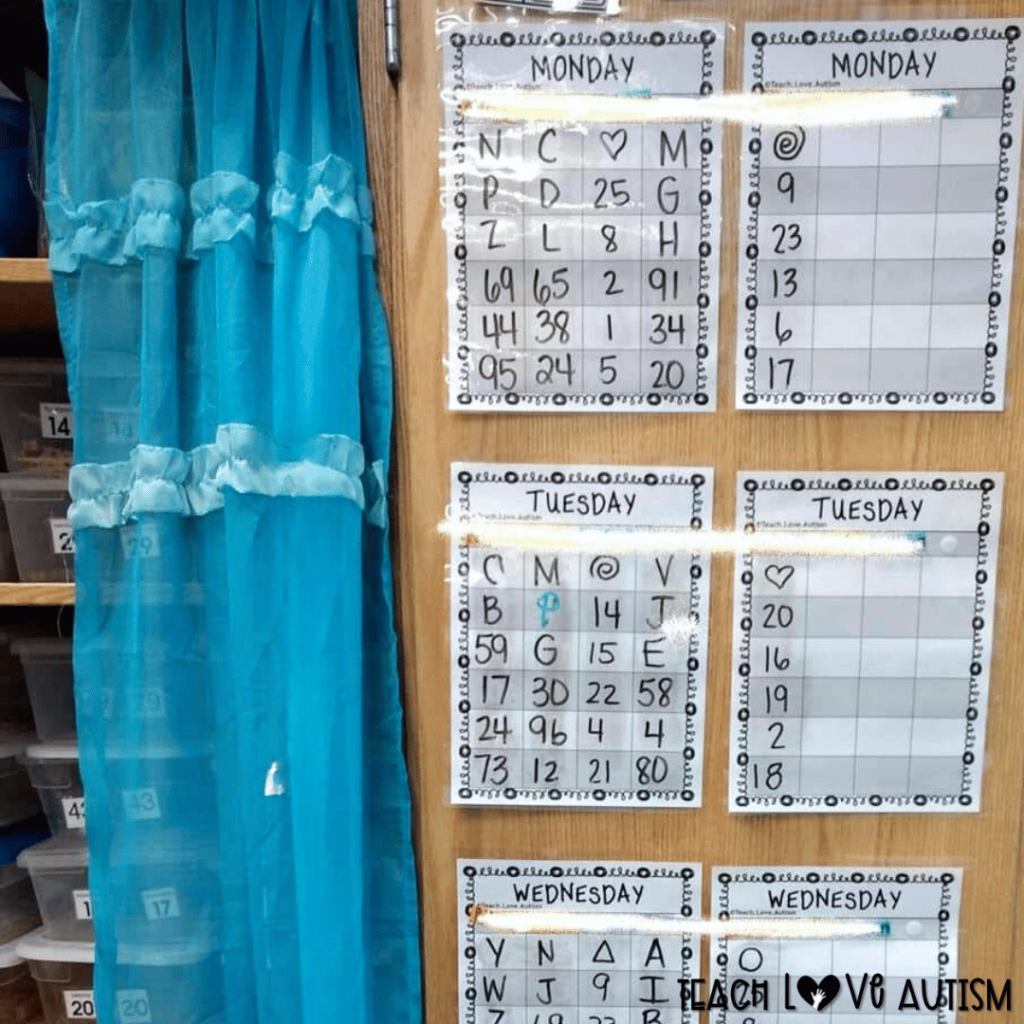
Behind that blue curtain in my classroom, you’ll find my beloved work tasks, all neatly organized and ready for action. I’ve carefully arranged each task in its own plastic bin. This makes it super easy to grab and go when it’s time for students to work independently. These bins are a lifesaver for keeping everything organized and accessible. My favorite part is that they stack perfectly, so I can fit many tasks on the shelves without taking up too much space.
I added a black shelf with about 25 more tasks in these bins, and I even have more stacked. You can never have too many options for keeping students engaged! Each task inside the bin is thoughtfully prepared. The needed materials are also inside the bins to avoid rushing around the room. I also make sure I have a variety of options that cover a range of skills. This helps me to provide my students with what they need to work on. It’s rewarding to see my students grow with the help of these work tasks. I feel a little proud every time I look at them, all lined up and ready to make a difference!
Scheduling Independent Work Stations
Now, if you’re like me, you’ve probably realized that keeping everything organized is key to making independent work stations successful. Let’s be real. Juggling all the materials and ensuring everyone knows what they’re supposed to be doing can sometimes feel like a balancing act. That’s where a little strategy comes in handy. And yes, it involves schedules. Yes, another one, but I promise it’s worth it!

I know it hurts to think that you have to come up with another fool-proof schedule in your classroom. However, having a schedule and understanding of who is completing work and when will be your best friend! If your classroom is anything like mine, you probably already have multiple schedules going on. There’s the regular building schedule, the teacher’s job duty schedule, the paraprofessional job duty schedule, the students’ work schedule, and even a schedule for collecting data and working on IEPs. And, honestly, the list could keep on going!
If you haven’t already added a schedule for your work tasks, now’s the time to do it. The amount of time and headaches this will save you is incredible. Your students will know exactly what they should be working on. Your staff will be on the same page, too. It’s a win-win that makes everything run so much smoother!
Now, let me give you a glimpse of what my work task schedule looks like in action. Below is a picture of how I organize it all. Each student has their own unique set of boxes, and no one else in the room gets the same set on that day. This way, there are no mixups, and everyone knows exactly what they’re supposed to be working on. Plus, I make sure that students don’t repeat the same box during the week. Unless, of course, I make a special exception. This system keeps everything running smoothly and ensures that each student is getting the variety they need to stay engaged and challenged.
Where Do You Keep This Schedule?
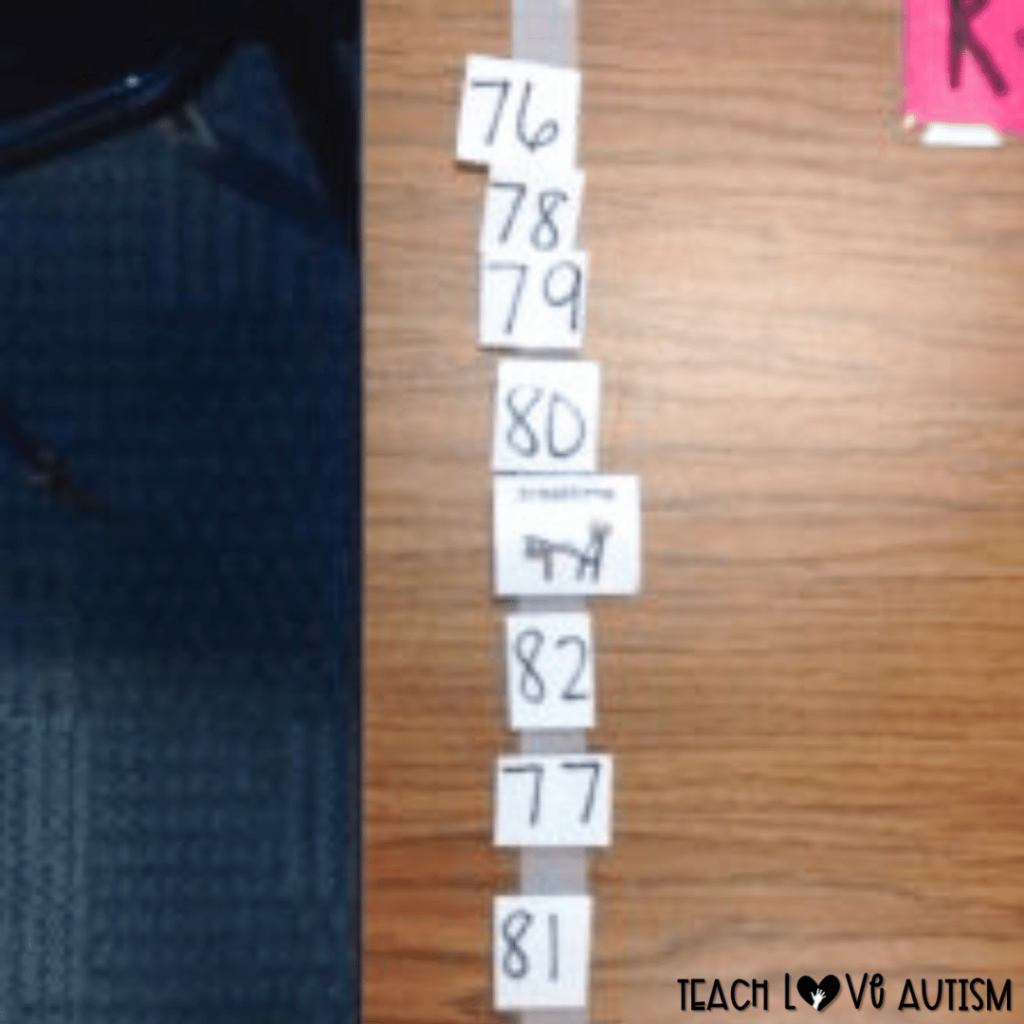
I keep this schedule right next to my shelves of work tasks. This makes it super easy for everyone in the room to see what each student is working on. It’s simple, easy to read, and totally user-friendly! I also make sure to laminate these schedules. I just jot down what each student completes with a dry-erase marker. It can be easily updated whenever needed. It’s a small detail that makes a huge difference in keeping everything organized and on track.
Once I got comfortable with using independent work stations, I looked for ways to improve the schedules and systems for my students. I had one of my students start putting the numbers or letters on the desks as part of their morning chores. It turned out to be such a meaningful job for them and a huge help for our classroom! Not only did it keep things organized, but it also gave the student a chance to practice some functional skills, like following a schedule. It was a win-win situation that made our mornings smoother and provided great practice for the student. I love when something as simple as a classroom chore can have such a positive impact!
When do Independent Work Stations Happen?
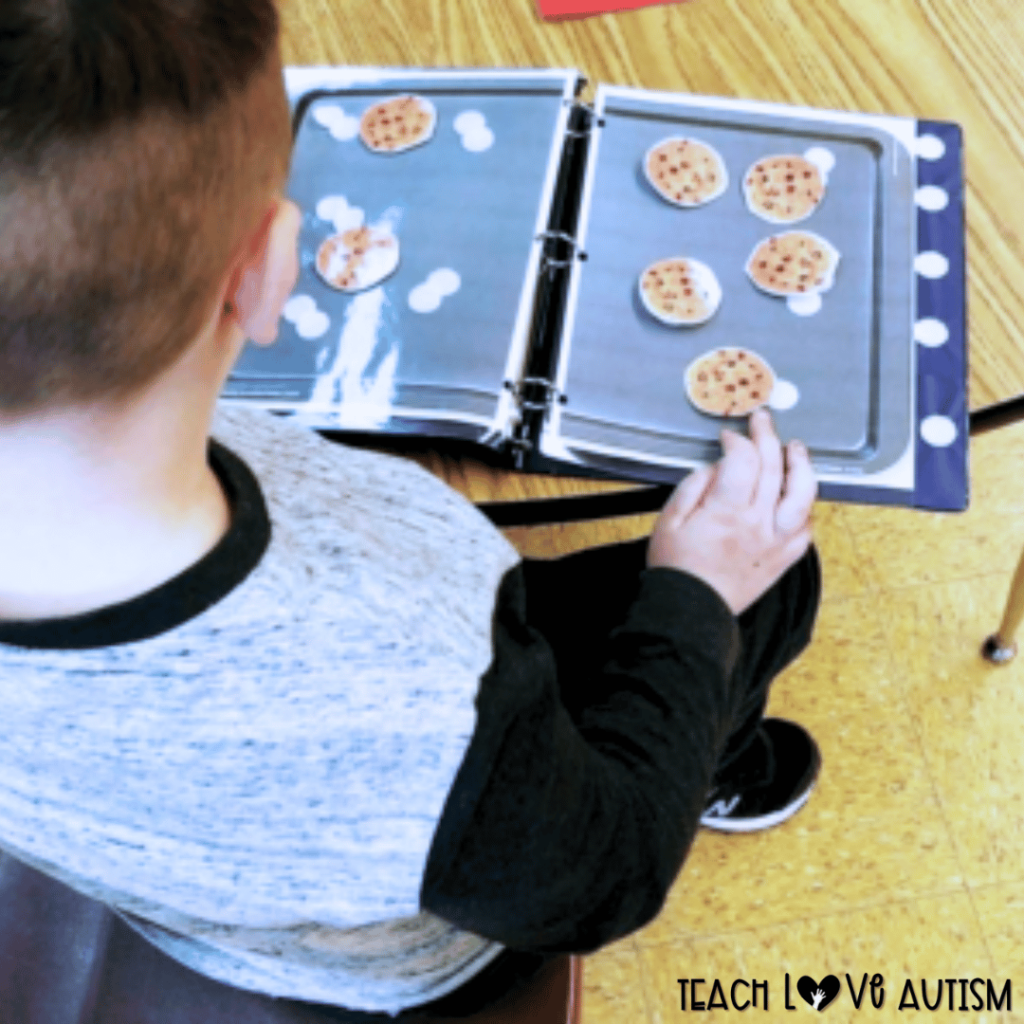
Within my classroom schedule, each student has dedicated time to work on their specific work task boxes for the day. Each day, they get a different set of boxes, which keeps things fresh and interesting. Now, I have had students in the past who couldn’t quite handle switching up boxes every day. They would stick with the same ones over and over. While I’m not a huge fan of this approach since life isn’t the same every day, I found that for this particular student, it worked well, and that’s what mattered most.
During their “Work Task” time, and even during any “downtime” they might have, students work to complete their boxes. Once they finish what’s on their desk, they earn a well-deserved break. I’ve adapted this system for my students who need more frequent breaks. Some students take breaks between boxes, while others might need a break halfway through. It just depends on how long they can work independently. It’s all about finding that sweet spot where they can succeed and feel good about their progress.
Visuals for Independent Work Stations
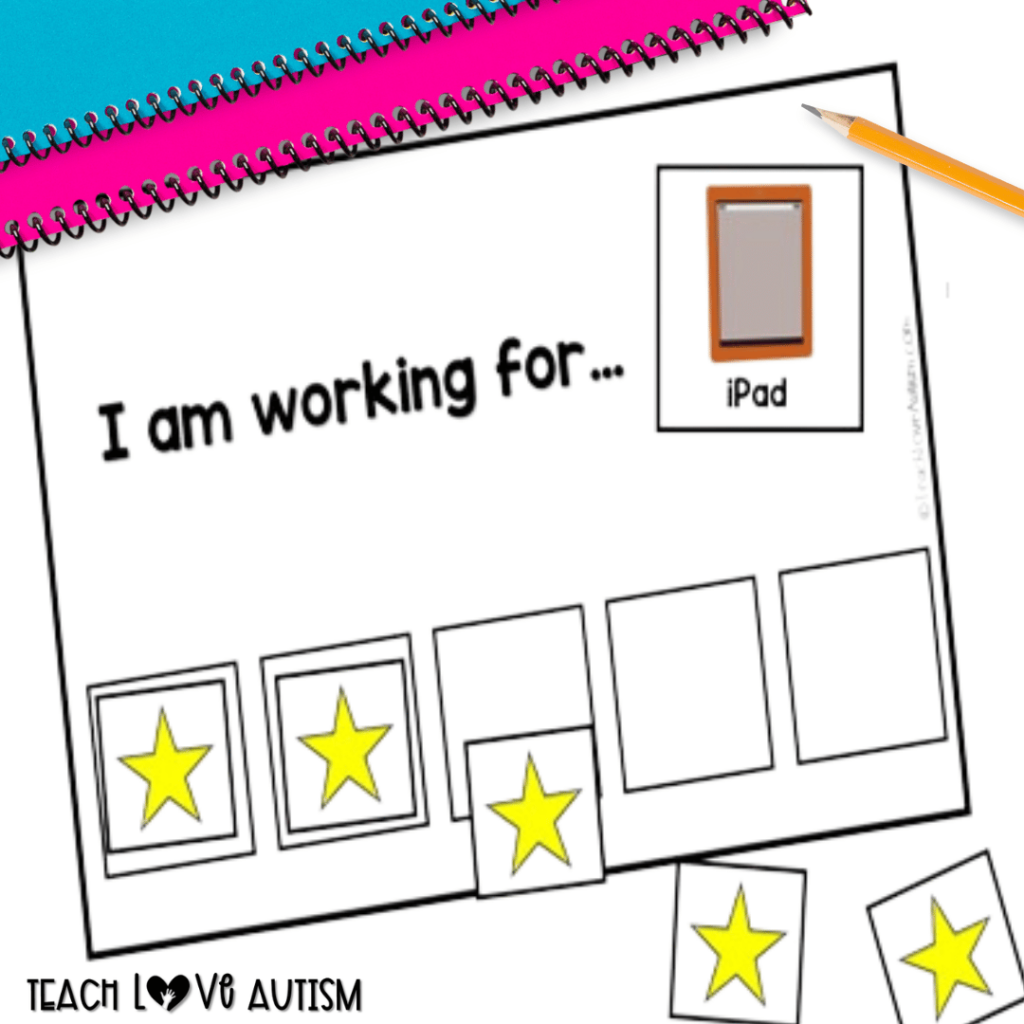
Another fantastic tool you’ll want to incorporate to help your students stay on task is visuals. Visuals are a game-changer in the classroom, especially for students who thrive on clear, concrete cues. They not only guide students through their tasks but also provide a sense of accomplishment as they see their progress.
I’ve created a visual that you can use for free, and it’s been a real hit in my classroom! This visual helps students stay focused by allowing them to choose a reward to work toward. This could be a favorite activity, a preferred item, or simply a break. The process is simple. The student selects what they want to work for, and as they complete each task, they earn a star in the boxes. Once all the boxes are filled with stars, they’ve earned their reward, and it’s break time! This system motivates students to stay on task and reinforces the importance of working toward a goal.
What I love about this approach is that it gives my students a sense of control and ownership over their work. Plus, it’s flexible enough to adapt to different students’ needs. Some may prefer to work for tangible rewards, while others are motivated by the promise of a short break. Either way, visuals like this one make the whole process clear and rewarding for everyone involved.
Additional Resources for Independent Work Stations
If you’re excited about diving deeper into independent work stations and work tasks, you’re in luck! I’ve written a few more posts that explore different strategies, tips, and ideas to help you make the most of these tools in your classroom. Whether you’re just getting started or looking for ways to refine your current setup, these resources will give you even more insights and inspiration. Let’s take a look at what else you can explore!
- 5 Steps to Launch Independent Work Stations
- Differentiating Independent Work Stations for the Autism Classroom
- The Ultimate Guide to Setting Up the Perfect Independent Work Stations
Give Your Students Essential Skills with Independent Work Stations
As you can see, independent work stations are so much more than just a classroom routine. They’re a powerful tool that can help our students build independence, confidence, and essential skills. I hope you feel inspired to give them a try or maybe even refine the system you already have in place. Remember, it’s all about finding what works best for your students and your classroom. With a little creativity, organization, and the right strategies, these stations can truly make a difference.
Save for Later
Remember to save this post to your favorite special education Pinterest board for quick access to these resources for independent work stations.
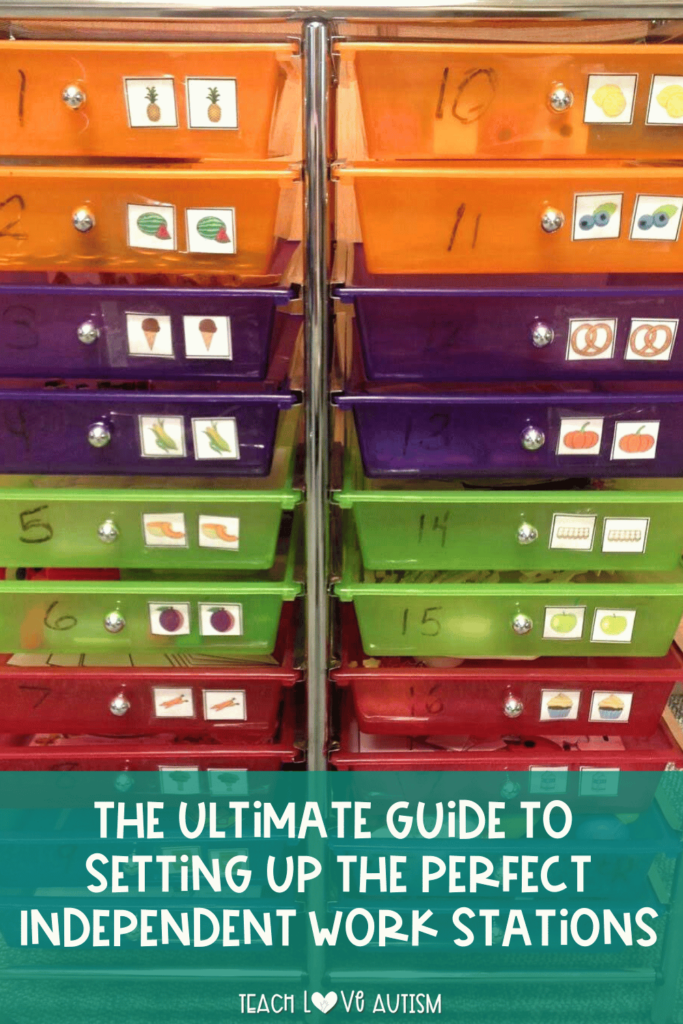



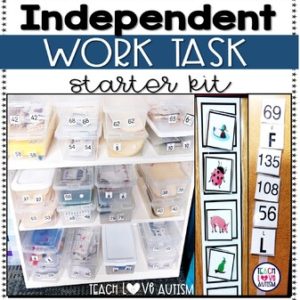


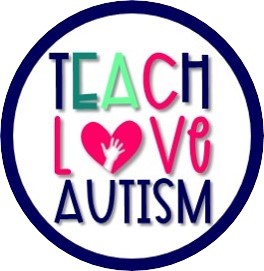
4 Responses
Your very organized! Do they do work boxes all day, everyday of the week or is this something that can be completed in an hour or two?
Thanks. No, I have set times in my schedule for students to work on their work tasks. Most of the time it takes them about 30 minutes maybe a little more to complete. Check this blog post with my schedule in it. http://teachloveautism.blogspot.com/2014/08/2014-2015-classroom-schedule.html
Yes, I found the schedule after I posted that! I was just letting my kids work in the boxes in their free time but there doesn't seem much time for that lately. I think I will try to work it into the schedule as well.
Karen, that seems to work well for me. I know that sometimes it is nice to have a filler when you get done something too early but, it has been a great independent work time for my students as well.